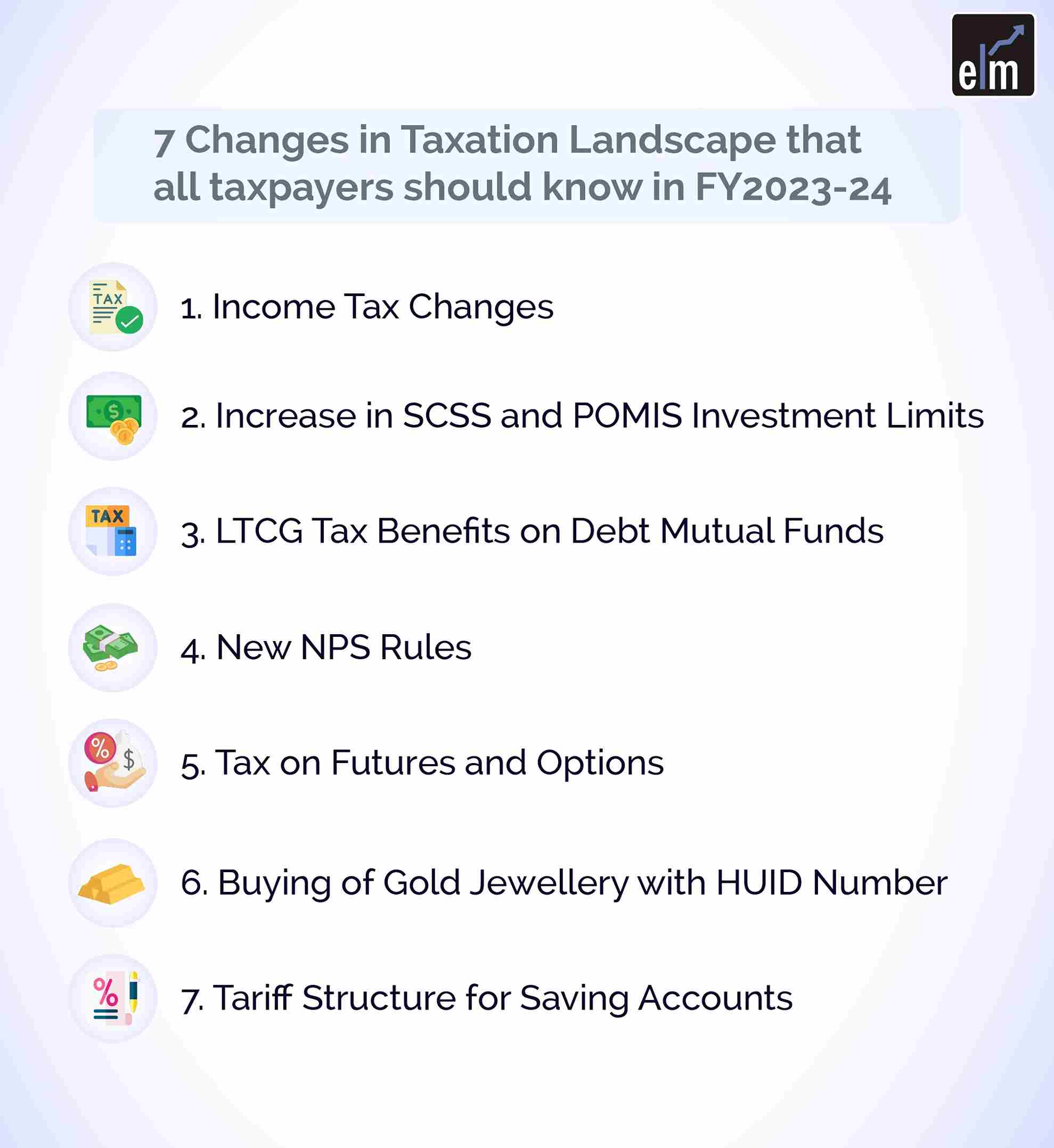Because of the income-tax changes announced in Budget 2023, several changes will affect Indian taxpayers in their tax planning beginning on April 1.
The start of a new fiscal year is an excellent time to review your investments and financial goals. Keep an eye on the Reserve Bank of India (RBI) policy announcements, whether you have a loan or plan to take one.
There are also significant changes in tax rules, the withdrawal policy from the National Pension System (NPS), and investments in post-office schemes, among other things. So, what changes will affect your wallet in April 2023?
Because of the income-tax changes announced in Budget 2023, several changes will affect Indian taxpayers beginning on April 1.
So, In today’s blog, let us discuss 7 Changes in the Taxation Landscape that all taxpayers should know at the start of the financial year 2023-2024:

1. Income Tax Changes–Tax Planning
If a person does not specify which regime they will submit their returns under, the new regime will default. Under the new regime, the rebate limit has been raised from Rs 5 lakh to Rs 7 lakh. From April 1, new income-tax slabs will be implemented under the minimal exemptions regime.
The limit on leave travel allowance encashment was increased from Rs 3 lakh to Rs 25 lakh in Budget 2023, the effective fiscal year 2023-24. Income earned on traditional endowment life insurance policies will be taxable at maturity if the aggregate annual premiums exceed Rs 5 lakh in a fiscal year, according to Budget announcements.
If physical gold is converted to electronic gold or vice versa, investment in market-linked debentures will be considered short-term capital assets with no capital gains tax.
2. Increase in SCSS and POMIS Investment Limits
Budget 2023 has increased the appeal of two crucial financial investments popular among senior citizens. The maximum limit under the Senior Citizen Savings Scheme (SCSS) has been increased from Rs 15 lakh to Rs 30 lakh as of April 1.
The scheme guaranteed an interest rate of 8% per year from January to March 2023. The interest is paid every quarter.
Furthermore, the investment limit for the popular Post Office Monthly Income Scheme (POMIS) has been increased from Rs 4.5 lakh to Rs 9 lakh. The investment limit in POMIS joint accounts has been increased from Rs 9 lakh to Rs 15 lakh. From January to March 2023, the scheme paid a monthly interest rate of 7.1 percent.
SCSS and POMIS both have a five-year lifespan from the date of investment. SCSS accounts can be extended for three years after they mature.
These schemes are backed by a sovereign guarantee, so there is no credit risk. These schemes are popular among senior citizens who require a steady source of income.
3. LTCG Tax Benefits on Debt Mutual Funds
Debt mutual funds will lose a significant tax advantage over fixed deposits. Capital gains on debt mutual funds — schemes that invest less than 35% in Indian equities — will be added to your income and taxed at the applicable slab rate beginning April 1.
Capital gains on debt funds are currently considered long-term if units are held for more than three years (up to March 31). Such long-term capital gains (LTCG) are subject to a 20% tax after indexation, which reduces the tax payable. This benefit will be phased out beginning April 1.
4. New NPS Rules
The Pension Fund Regulatory and Development Authority (PFRDA), the pension regulator, has made the uploading of certain documents mandatory beginning April 1, 2023, in order to make annuity payments faster and easier for subscribers.
NPS exit/withdrawal forms, proof of identity and address as specified in the withdrawal form, bank account proof, and a copy of the PRAN (Permanent Retirement Account Number) card were all required to be uploaded to the CRA (Central Record-keeping Agency) system.
After five years of contributions in the Tier I NPS account, you can withdraw 25% of your contributions. You can withdraw for specific reasons such as illness treatment, disability, funding higher education or child marriage, and property purchase. The regulator allows you to withdraw a maximum of three times during the investment period.
5. Taxation on Futures and Options
The tax authorities treat income from derivatives trading as business income. Even if the investor is a salaried taxpayer, a business partner, or a pensioner, futures, and options gains (or losses) will be treated as business income.
As a result, the gains will be added to the individual’s total income and taxed at the standard slab rate. Remember that in the event of a loss, the return must be filed by the due date.
6. Buying of Gold Jewellery with HUID Number
Only hallmarked gold jewelry with a Hallmark Unique Identification (HUID) number will be permitted to be sold in all Indian jewelry stores beginning April 1. The HUID number is a six-character alphanumeric code.
It will be assigned to each piece of jewelry during the hallmarking process and will be unique to each piece of jewelry. It provides transparency and allows the buyer to obtain an accurate valuation of the gold purchased.
7. Tariff Structure for Saving Accounts
Axis Bank’s tariff structure for savings and salary accounts was revised on April 1. The bank, for example, has revised the average balance requirement criteria for Prestige savings accounts. The average quarterly balance (AQB) of Rs 75,000 has now been converted to the average monthly balance (AMB). (AMB).
Furthermore, charges for failure to maintain a minimum average balance have been revised. Existing fees range from NIL to Rs 600. It will be Rs 50 to Rs 600 starting in April. If the threshold falls below 25% of the required balance, the bank charges a non-maintenance fee. For non-financial reasons, the bank increased the inward cheque return charges from Rs 50 to Rs 150 per transaction.
You can also join our course on Online NSE Academy Certified Capital Market Professional (E-NCCMP)
Bottomline
Starting with this financial year (April 1, 2023), make sure you begin your tax planning as soon as the year begins.
We hope you found this blog informative and use the information to its maximum potential in the practical world. Also, show some love by sharing this blog with your family and friends and helping us spread financial literacy.
Happy Investing!
In order to get the latest updates about Financial Markets visit StockEdge






